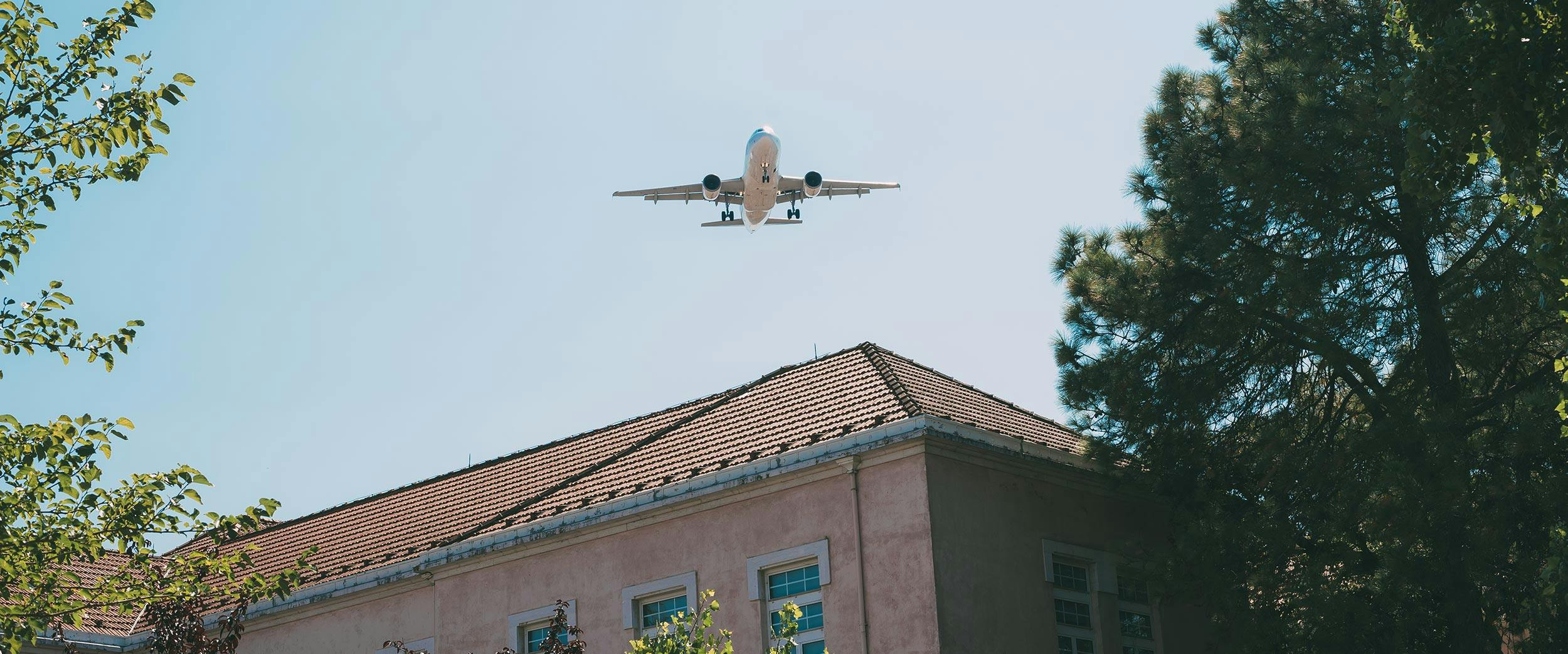
If your neighborhood is located near an airport, chances are things can be pretty noisy between the aircraft take-offs and landings. New technology has contributed to increased efficiency and greener travel, and allowed flights to become less expensive. Additionally, a healthier economy that means air travel industry is surging, seeing a higher demand, needing more jets—and creating more noise.
In addition to disturbing residents (and their pets) and being a nuisance within your homeowner’s association, repeated exposure to noise pollution can have adverse health effects. Though the FAA (Federal Aviation Administration) can be a tricky beast to challenge, some HOAs have had success due to collective bargaining power in getting airports to change their flight patterns to minimize noise pollution over their neighborhoods.
When your residents have had enough, here are some tips and strategies to take when going through a noise abatement procedure with your local airport.
Noise Pollution Defined
Noise is traditionally and generally defined as undesired or disturbing sound that interferes with one’s ability to do something. Sound becomes unwanted when it makes normal activities such as sleeping and holding conversations difficult, or when it disrupts or diminishes one’s quality of life. Noise is annoying, especially when it is persistent and loud. It also can have major health consequences as well.
Side Effects of Repeated Exposure to Loud Noise
There have been multiple studies that link noise to mental and physical health problems, particularly in those located close to airports. Common problems caused by constant or high levels of noise exposure include cardiovascular issues (high blood pressure, heart attack, stroke, coronary artery disease, type 2 diabetes), stress related illnesses, speech interference, permanent Noise Induced Hearing Loss (NIHL), sleep disruption, and lost productivity and cognitive performance. The closer subjects lived to an airport, the more significant the effects.
Subtle disturbances from noise that impact sleep, activity, and communication trigger a number of emotional responses, including anxiety and chronic stress. A study from Massachusetts General Hospital revealed that high levels of environmental noise exposure may fuel activity in a region of the brain associated with stress regulation. The strain of chronic stress becomes present in cardiovascular disease risk areas because of the repeated exposure to situations that trigger our acute stress “fight or flight” reaction, aka an increase in heart rate, breathing rate, muscle tension, and blood pressure due to a release of hormones, including adrenaline. When this experience becomes commonplace, chronic stress sets in.
Not only do these traits affect humans, they affect animals, which means the pets in your neighborhood are also impacted by noise pollution. Overall, the negative health effects and disruption to normal activity by chronic noise can build up to a lessened quality of life. To find out how significant the noise pollution is near your HOA, visit the National Transportation Noise Map.
Noise (Sound) Abatement Defined
To combat noise pollution and its impact on local neighborhoods, airports will typically engage in noise abatement. According to USLegal, noise abatement is the set of measures taken to reduce unacceptable levels and types of noises and vibrations, or the procedures to protect people from exposure to these sounds. The primary responsibility of noise regulation falls to state and local governments. However, the EPA has the authority to investigate instances of noise and its effect on communities, respond to inquiries on matters related to noise, and evaluate the effectiveness of existing regulations for protecting the public health.
If your association poses a complaint and get the EPA involved, they will carry out a full and complete investigation and study of the noise, which involves analyzing its effect on the public health and welfare, causes/sources, and psychological and physiological implications on humans, wildlife, property, and the public at large.
Additionally, when it comes to noise abatement surrounding airports, the FAA will also likely be involved.
Strategy #1: Submit a Formal Complaint to Your Airport
Per the FAA, you should first contact your local airport with your airport noise issues and concerns.There should be a manager or staff who respond to airport noise issues. Multiple airport authorities have a hotline and staff dedicated to a noise management program. For example, Massport (serving Boston’s Logan Airport) allows you to submit complaints through an online portal or via phone call. When Massport receives a complaint, the date and time are researched and a response is generated within a few weeks. The report will normally include information such as aircraft operations, altitude relative to your address, meteorological information, and runways in use. The Minneapolis-St. Paul Metropolitan Airports Commission offers a similar service and The Columbus Regional Airport Authority has a page of FAQs and resources in addition to a hotline.
If your complaints are regarding military aircraft because you live near a base, the FAA recommends contacting their noise office or community relations department.
Strategy #2: Take it to the FAA
If working with your local airport is unsuccessful, email the FAA at 9-awa-noiseombudsman@faa.gov. The FAA’s Aviation Noise Ombudsman (person in charge of investigating and settling complaints) serves as a liaison with the public on issues regarding aircraft noise. When submitting your specific question, comment, concern or complaint, you must provide the following details:
- Your name
- Street address or cross streets where the event(s) occurred
- Zip code
- State
- Approximate start date(s) and time(s) you are experiencing the noise disturbance
- A description of the noise disturbance and location description
- The type of aircraft causing the complaint (i.e., jet, helicopters, propeller, unknown)
- A description of the aircraft (e.g. color, number and placement of large wings) and number and placement of engines (tail, body, wing)
- Airport source of departure or arrival
- If this is a repeat occurrence
- Officials contacted to date, including their name, office title, and how they were contacted (such as email, letter, or phone), if you have reached out
You can send a letter or make a phone call to the FAA as well, but they recommend the fastest and most effective form of contact is via email as the request can be distributed to the proper subject matter expert ASAP.
For concerns regarding planes that are flying too low over your neighborhood, you can contact your local Flight Standards District Offices (FSDO). When planes are flying too low, the noise is that much closer to the homes in your association.
The FAA is involved in noise control measures to reduce the sound at the source, which includes soundproofing and buyouts of buildings near airports and land use planning strategies. Look into if your community can become part of a sound insulation program and if you can share the voices of your community when it comes to configuring runways. Contact the FAA Airports Regional & District/Development Office that services your community for more information.
Strategy #3: Work with Other HOAs and City Officials
If your association is unhappy with the noise, chances are others in the surrounding community are also frustrated. Form a committee with a specific goal of noise abatement (e.g. curfew, changed flight pattern, etc.). Hold meetings and advertise it throughout your community—the more people you can bring on board to share the responsibility and add their name to a petition, the better. When you work together you can have a real impact, like in the situations below.
Hawthorne Municipal Airport Adopts a Voluntary Noise Reduction
After years of struggling to get through to pilots, Hawthorne City Council finally made some headway in fall 2018. Residents who were fed up with the excessive noise and unsafe flight patterns and frustrated with the FAA’s lack of support, worked with the town to enact voluntary measures with the airport. One particular resident helped organize a group of seven neighborhood associations concerned about the increased jet noise from the airport, which can end as late as midnight and start as early as 4 AM. In many instances, city officials were able to identify pilots who frequently flew too low over neighborhoods. They recorded the tail numbers and directly notified the offending pilots.
As a result of teamwork between residents, city officials, and the airport, the voluntary measures include confining flight patterns when circling the airport, increasing elevation on landing approaches, limiting engine run-ups on the ground and installing airplane mufflers.
Curfew at East Hampton Airport
When a helicopter start up reduced the cost of flights to New York City’s favorite summer vacation spot in 2014, locals banded together to effect a curfew on all airport activity year round. Vocal townspeople from East Hampton and surrounding towns and members of the noise abatement were able to work together to have the city enact a solution. In 2015 The Town Board was responsible for conducting a study and proposing regulations that would not significantly impact the surrounding area or neighboring airports with overflow flights.
All flights are now prohibited from leaving and entering East Hampton between 11 PM and 7 AM. Noiser aircrafts must observe a curfew that stops louder flights from 8 PM to 9 AM. Aircraft classified as noisy (any plane or helicopter that has an Effective Perceived Noise in Decibels approach level of 91.0 or greater) would be limited to one takeoff and landing per week between May and September.
However, a court order lifted the curfews following the 2016 summer season. Helicopter traffic continues to grow, and the town is continuing to fight it.
The City of Phoenix Vs. The FAA
When the FAA changed the paths for Phoenix Sky Harbor International Airport in September 2014 as part of the national NextGen program for airway safety and efficiency, the airport logged thousands of noise complaints from people who say their quality of life has decreased drastically as a result of the increased noise from new paths. The FAA said the new paths are safer, more efficient, and saved fuel, but the city argued those benefits were too loud to bear.
As a result, the city filed a lawsuit against the Federal Aviation Administration and won. The residents spearheaded the effort and worked alongside the City of Phoenix legal team, during which a study was conducted and found that flights rarely followed the new paths, which violated multiple federal laws The court’s decision allowed Phoenix Sky Harbor International Airport to return to pre-existing flight paths.
Strategy #4: When All Else Fails, Soundproof
Sometimes we don’t always get what we want, even when we try really hard. If your efforts are denied, consider recommending some soundproofing strategies to your homeowners. Some involve extensive construction on behalf of homeowners, while some are simpler and less expensive.
- Get a sound machine: Sound machines (or apps) can be an inexpensive solution to provide calming sounds to cover up disruptive noise, especially when sleeping.
- Insert fiberglass insulation or drywall panels: Mass is a key factor in reducing noise. Where appropriate (like the attic), install these construction materials to absorb noise. Consider upgrading your decor as well (soft carpets, heavy curtains) to reduce wall space and aid in absorption. Note: when your walls are bare, the chances of sound echoing is amplified as it has more room to reverberate.
- Seal gaps: Use acoustical sealants or door sweeps/seals to prevent any sound from leaking in where there’s a gap.
- Install pre-built windows and doors engineered to be soundproof: These materials are specially designed to block sounds from outside.
The Right to Quiet Enjoyment
Everyone has the right to quiet enjoyment of their homes. That doesn’t necessarily mean freedom from noise, but your association can do its best to abate any kind of noise, from airports and otherwise. Try some of the solutions in this post, and consider working with an association manager who can offer their expertise in tricky situations like these.
